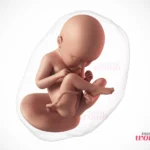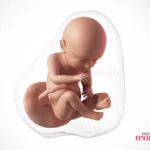When you are 36 weeks pregnant, the baby’s head may start engaging or dropping into your pelvis!
Congratulations, You have only one month left! Your uterus expands even more. At this point, you may think that you will not become any bigger, but remember that there are four more weeks to go. Your belly will most likely grow larger over the next four weeks.
During this period, make sure to avoid traveling far from your house. If there is no chance to avoid traveling, then you need to take the doctor with you to the place you are traveling. It helps ease some of the stress of being away from home during this period. Gestational diabetes prevention
This is the time to make some needed preparations, such as having a car for transportation to the hospital, having a person accompany you to the hospital, registering a maternity center for your delivery, buying required things for your child, decorating the baby nursery, and deciding on your baby’s name. Still, there are many more exciting things happening to you and your baby. Read on to know more about what is happening to you and your baby…
Symptoms experienced by a 36 weeks pregnant woman:
When you are 36 weeks pregnant, you are possibly more concerned with your labor and delivery. Staying calm and active without experiencing any stress will help you greatly for the upcoming four weeks. If you want to deliver a full term baby, you need to be as healthy as possible until 37 weeks pregnant. When the baby is full term, you can deliver the baby at any time between 37 and 42 weeks.
During pregnancy week 36, you may notice an increase in the frequency of Braxton Hicks contractions. These contractions are not only frequent, but also excruciatingly painful. This makes them what many people mistakenly consider labor pains. Remember that when you have more frequent contractions, try to change positions. If the contractions go away when you change positions, then they are false labor pains. True labor pain won’t go away when you change positions or do something else at that time. So, if you recognize them as true labor pain, contact your healthcare provider immediately.
Clumsiness is another common pregnancy symptom you experience during the 36th week of pregnancy. When you think about how big your belly is, it is no wonder that you are stumbling into things more clumsily than normal. Hormonal changes can cause the pelvis and pelvic joints, as well as the joints in the toes and fingers, to become loose.
Hip pain can also be a common and distressing symptom, especially during the last 36 weeks of pregnancy. Hip pain is also due to the hormonal fluctuations that make you clumsy. During pregnancy’s third trimester, relaxin hormone is released in greater amounts to relax and soften the joints in your pelvis. These hormonal fluctuations, combined with the added pressure of carrying 20 pounds or more, can cause discomfort and severe hip pain.

Physical changes that occur in a 36 weeks pregnant woman:
When you are 36 weeks pregnant, you may begin to see your healthcare provider each week until your delivery. During this period, your obstetrician may perform an internal examination to find out whether cervical dilation or cervical effacement has begun.
This is the week for lightning to strike, as the baby’s head descends into the pelvis. This is the primary step in preparation for labor and birth. For first time mothers-to-be, lightening occurs only a few weeks before labor starts. So, for first-time pregnant women, the baby may drop this week, next week, or the following week.
When the baby is in this position, there will be less pressure on your stomach and lungs, and your appetite will grow larger. Due to this head down position, you may feel slight numbness or tingling sensations around the pelvis region. This is due to the pressure of the baby on your nerves in the legs and pelvis. When the baby drops down into your pelvic region, this pressure may sometimes lead to hemorrhoids, in which veins around the lower rectum and anus become inflamed or swollen. When you notice this condition, immediately talk to your doctor.
Fetal changes that occur in a pregnant woman:
When you are 36 weeks pregnant, the baby is around 20.5 inches long and weighs about 6 pounds.
During this final month, the baby is concentrating more on breathing, swallowing, and sucking. This makes the baby prepare for life outside the womb.
By week 36 of pregnancy, your baby’s bones are almost strong enough to attain a solid composition that can allow the baby to live in the outside world.
By week 36, the baby’s muscle tone had also improved. Genital development was also completed this week. For baby girls, the labia are completely developed, and for baby boys, the testes are already descended.
Now the baby is able to swallow and even digest the milk. Also, the baby’s gums are becoming stronger. The only organ that requires development is the lung. Within a few weeks, the lungs are also fully developed.
By this period, your baby has almost fully developed kidneys. The legs and arms will start dimpling at the knees and elbows, and there will also be the formation of creases around the wrists and neck due to the fat deposition. Obstetrics
What care should be taken by a 36 weeks pregnant woman?
Reducing the stress levels and relaxing as much as possible will help make the labor and delivery an easy process.
Practicing abdominal breathing will help ease some discomfort. If you already practice pregnancy yoga or Lamaze methods, then you can easily do abdominal breathing. If you observe any severe changes in your baby’s movements, immediately contact your care provider.
Practice visualization techniques. Visualizing your labor process can help you deal with its painful aspects. A positive mental state and a relaxed attitude will help with oxytocin secretion, thus leading to muscle relaxation. This entire process helps to ease your labor pains.
Have a wonderful pregnancy journey! Go on to know more about the exciting things during pregnancy week 37…









